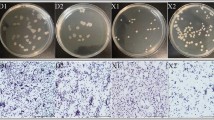Abstract
The identification and characterization of Bacillus mojavensis KJS-3 was performed by in vitro tests. A 16S rDNA sequence and phylogenetic tree demonstrated that this isolate belongs to the B. mojavensis group. B. mojavensis KJS-3 supplies nutrients by synthesizing several vitamins. B. mojavensis KJS-3 produces α-amylase and protease. B. mojavensis KJS-3 is cultured well under aerobic conditions without gas production. B. mojavensis KJS-3 allows for assimilation of cholesterol and bile salt hydrolase activity. Finally, adhesion experiments using Caco-2 cells revealed that the adherence of B. mojavensis KJS-3 to Caco-2 cells was approximately 51.2±8.14%.
Similar content being viewed by others

References
Salminen S, Wright A von. Current probiotics-safety assured? Microb. Ecol. Health. D. 10: 68–77 (1998)
Fuller R. Probiotics in man and animals. J. Appl. Bacteriol. 66: 365–378 (1989)
Lilly DM, Stillwell RH. Probiotics: Growth promoting factors produced by microorganisms. Science 147: 747–748 (1965)
Bacon CW, Hinton DM. Endophytic and biological control potential of Bacillus mojavensis and related species. Biol. Control 23: 274–284 (2002)
Roberts MS, Nakumora LK, Cohan FM. Bacillus mojavensis sp. Nov., distinguishable from Bacillus subtilis by sexual isolation, divergence in DNA sequence, and differences in fatty acid composition. Int. J. Syst. Bacteriol. 44: 256–264 (1994)
Bacon CW, Hinton DM. Symptomless endophytic colonization of maize by Fusarium moniliforme. Can. J. Botany 74: 1195–1202 (1996)
Bacon CW, Hinton DM. Potential for control of seedling blight of wheat caused by Fusarium graminearum and related species using the bacterial endophyte Bacillus mojavensis. Biocontrol Sci. Techn. 17: 81–94 (2007)
Choi SM, Park MH, Jung TS, Moon KH, Kim KM, Kang JS. Characterization of Bacillus mojavensis KJS-3 for industrial applications. Arch. Pharm. Res. 34: 289–298 (2011)
Kieser T, Bibb MJ, Buttner KF, Chater KF, Hopwood DA. Practical Streptomyces Genetics. The John Innes Foundation, London, UK. pp. 169–171 (2000)
Kim KM, Kim MJ, Kim DH, Park YS, Kang JS. Characterization of Bacillus polyfermenticus KJS-2 as a probiotic. J. Microbiol. Biotechn. 19: 1013–1018 (2009)
Altschul SF, Madden TL, Schäffer AA, Zhang J, Zhang Z, Miller W, Lipman DJ. Gapped Blast and psi-blast: A new generation of protein database search programs. Nucleic Acids Res. 25: 3389–3402 (1997)
Hompson JD, Higgins DG, Gibson TJ. Clustal W: Improving the sensitivity of progressive multiple sequence alignment through sequence weighting, position-specific gap penalizes, and weight matrix choice. Nucleic Acids Res. 22: 4673–4680 (1994)
Kumar S, Tamura K, Jakobsen IB, Nei M. MEGA: 2: Molecular evolutionary genetics analysis software. Arizona State University, Tempe, AZ, USA (2001)
Kim P, Kim CH. A study on the simultaneous analysis of fat-soluble vitamins in food stuffs and vitamin products by high performance liquid chromatography. J. Korean Chem. Soc. 33: 46–54 (1988)
Korea Food & Drug Administration. Detection and quantitaion of vitamins in foods. Available from: http://www.kfda.go.kr/fa/index.do?nMenuCode=23&mode=view&boardSeq=14001. Accessed Feb. 14, 2011.
Korea Food & Drug Administration. Detection and quantitaion of digestive enzymes in foods. Available from: http://www.kfda.go.kr/fa/index.do?nMenuCode=23&mode=view&boardSeq=14001. Accessed Feb. 14, 2011.
Durham HE. A simple method for demonstrating the production of gas by bacteria. Brit. Med. J. 1: 1387 (1898)
Jeong HY, Kim TH, Park JS, Kim KT, Paik HD. Antioxidative and cholesterol-reducing activity of Bacillus polyfermenticus SCD. Korean J. Biotechnol. Bioeng. 18: 371–376 (2003)
Klaenhammer TR, Kleeman EG. Growth characteristics, bile sensitivity, and freeze damage in colonial variants of Lactobacillus acidophilus. Appl. Environ. Microb. 41: 1461–1467 (1981)
Jun KD, Kim HJ, Lee KH, Paik HD, Kang JS. Characterization of Bacillus polyfermenticus SCD as a probiotic. Korean J. Microbiol. Biotechn. 30: 359–366 (2002)
Casciari JJ, Riordan NH, Schmidt TL, Meng XL, Jackson JA, Riordan HD. Cytotoxicity of ascorbate, lipoic acid, and other antioxidants in hollow fibre in vitro tumours. Brit. J. Cancer 84: 1544–1550 (2001)
Kwon SH, Lee PC, Lee EG, Chang YK, Chang N. Production of lactic acid by Lactobacillus rhamnosus with vitamin-supplemented soybean hydrolysate. Enzyme Microb. Tech. 26: 209–215 (2000)
Ouwehand AC, Tölkkö S, Salminen S. The effect of digestive enzymes on the adhesion of probiotic bacteria in vitro. J. Food Sci. 66: 856–859 (2001)
Daniel YCF, Richard DM. Rapid procedure for the detection of acid and gas production by bacterial cultures. Appl. Microbiol. 20: 527–528 (1970)
Hayward AC. Detection of gas production from glucose by heterofermentative lactic acid bacteria. J. Gen. Microbiol. 16: 9–15 (1957)
Gilliland SE, Nelson CR, Maxwell C. Assimilation of cholesterol by Lactobacillus acidophilus. Appl. Environ. Microb. 49: 377–381 (1985)
Grunewald KK. Serum cholesterol levels in rats fed skim milk fermented by Lactobacillus acidophilus. J. Food. Sci. 47: 2078–2079 (1982)
Panigrahi P, Tall BD, Russell RG, Detolla LJ, Morris JG Jr. Development of an in vitro model for study of non-O1 Vibrio cholerae virulence using Caco-2 cells. Infect. Immun. 58: 3415–3424 (1990)
Lopez M, Li N, Kataria J, Russell M, Neu J. Live and ultravioletinactivated Lactobacillus rhamnosus GG decrease flagellin-induced interleukin-8 production in Caco-2 cells1-3. J. Nutr. 138: 2264–2268 (2008)
Lee NK, Park JS, Park E, Paik HD. Adherence and anticarcinogenic effects of Bacillus polyfermenticus SCD in the large intestine. Lett. Appl. Microbiol. 44: 274–278 (2007)
Gueimonde M, Jalonen L, He F, Hiramatsu M, Salminen S. Adhesion and competitive inhibition and displacement of human enteropathogens by selected lactobacilli. Food Res. Int. 39: 467–471 (2006)
Lee YK, Puong KY, Ouwehand AC, Salminen S. Displacement of bacterial pathogens from mucus and Caco-2 cell surface by lactobacilli. J. Med. Microbiol. 52: 925–930 (2003)
Author information
Authors and Affiliations
Corresponding author
Rights and permissions
About this article
Cite this article
Kim, K.M., Jung, T.S., Ok, S. et al. In vitro characterization study of Bacillus mojavensis KJS-3 for a potential probiotic. Food Sci Biotechnol 20, 1155–1159 (2011). https://doi.org/10.1007/s10068-011-0158-7
Received:
Revised:
Accepted:
Published:
Issue Date:
DOI: https://doi.org/10.1007/s10068-011-0158-7



